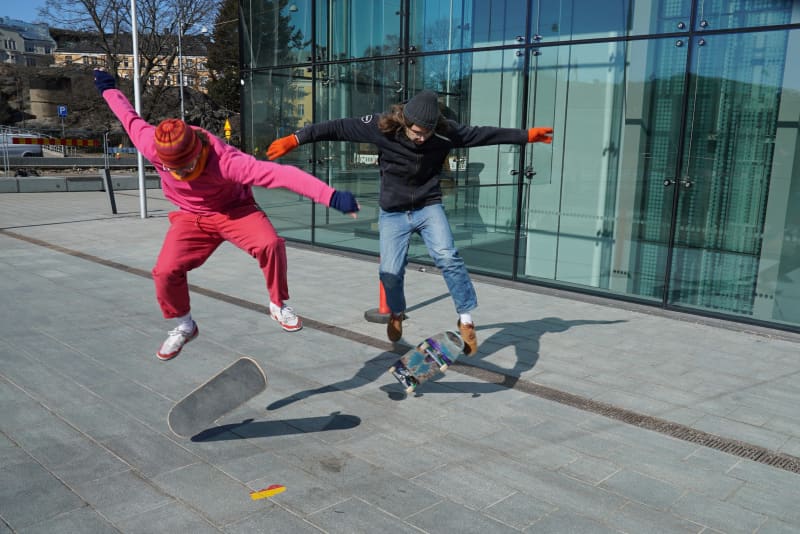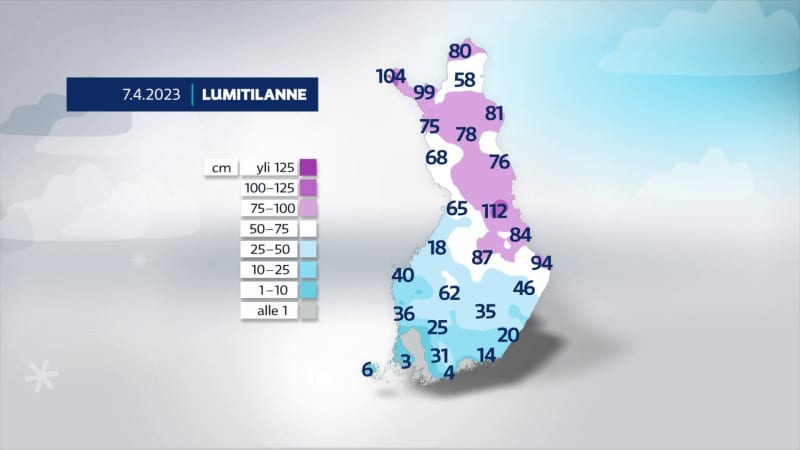
There is more than a meter of snow in places in Kainuu and Lapland, in the southernmost part of Finland, people are already skating on bare asphalt.
Tiling clean of snow, ice and sandblasting makes a skater who has been skating for 25 years smile.
– It feels very good to go skating. Year by year maybe even better, says Olli Aarni.
In a large part of Finland, however, kicksleds or skis are better exercise equipment than a skateboard.
The land is exposed only in a narrow area on the southern and southwestern coasts of the country. Tens of centimeters of snow is still enough in the rest of the country. In Kainuu and Käsivarren Lapland, the hankie rises to more than a meter in places.
Sunny and warm weather favors outdoor enthusiasts almost all over the country during Easter. The temperature hurts to ten plus degrees and more on several days.
Will this be the snow fairy’s fate?
The temperature, rising well above the plus side, melts the snow, but at night, a small frost freezes it. This slows down the melting.
– If it’s nice sunny weather and the air is dry, then the snow doesn’t melt on the surface. It can be even 10 degrees warmer and the hanki is completely icy.
Although many yearn for a quick thaw, Myllyniemi likes the night frost.
– The situation is actually quite optimal. When there are sunny days and night frost, the snow melts calmly. It curbs spring floods.
In frosty days, the snow does not melt, so the meltwater that has flowed into ditches and rivers during the day has time to flow forward, making room for the next day’s meltwater.
According to the old saying, \”new snow is the death of the old\”. However, this is not quite the case.
Snow melts faster in wet weather than in dry weather. Water rain melts the project effectively.
But if the rain comes as snow, the temperature is freezing and the air is dry.
– Snowfall does not bring as much thermal energy as rain. On the other hand, newly fallen snow melts faster than snow that has been on the ground all winter, says researcher Harri Myllyniemi.
The texture of new spring snow is loose. So it melts very quickly when the temperature rises to plus. Then the impression can arise that the new snow takes the snow cover with it.

Shining dazzling white in the spring sun, the hankie pleases outdoor enthusiasts and the first visitors to the terrace in spring.
Instead, the piles of snow blackened by sandblasting sand and traffic dust on the roadsides are unpleasantly eye-catching. From the skier’s point of view, the glistening spring slope is attractive, but the conifer needles accumulated on the slope in the forest’s trunk are a danger.
However, dirty and littered snow melts faster than clean snow.
– White snow reflects about 95 percent of heat radiation away. When debris starts to accumulate on the surface of the wind, it reflects only half or even less of the radiation. The heat bound to the sand or needles melts away the snow underneath, Myllyniemi explains.
The shape of the terrain also has an effect. The slopes leading to the south melt the snow the fastest. The earth’s surface is then tilted towards the sun, so it receives more thermal radiation than flat earth.
It is also important what kind of ground it is. For example, a field that has been tilled or left on the bed in the fall is unevenly covered with snow.
In spring, when the sun warms up, the snow melts on the higher peaks first. The snow cover starts to melt faster and easier around the thawed areas created in this way than on a flat field.
In open places, snow melts faster than in a forest or an area covered with other vegetation. On the other hand, there is often more snow in open places than in the forest.
Especially in the coniferous forest, there is often less snow on the ground than in the fields, because when it rains, the snow stays on the branches of the trees. From there it evaporates into the air and may never reach the ground.
Snow melts faster in urban areas than in rural areas. There are several explanations for this.
– Huge amounts of snow are being plowed away from the city. When the ground has been exposed, the snow melts more efficiently next to the bare ground. In addition, buildings heat up and reflect heat radiation around them, researcher Harri Myllyniemi explains.
In densely populated areas, driveways are salted and sidewalks are diligently sanded. The snow becomes dirty and melts away more easily when the sun warms it than the whiter paths in the countryside.
So what is the expert’s estimate of when the snow has melted all over the country?
– Finland is a long country! Now the snow is beginning to be less in Southwest and Southern Finland, but the melting will go towards June, for example in Käsivarren Lapland, where there is still more than a meter of snow.

